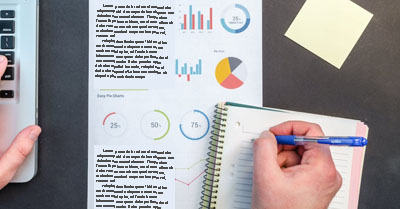Intermediate Reading Course. Section 2: Study Skills in Reading
Synthesizing All the Information as a Study Skill
Course Navigation
When Texts Are More than Just Text
A passage is often more than just text on a page. It often includes supporting materials such as pictures illustrating a concept that is easier to visualize than explain in words. Writers add different types of supporting materials depending on their purpose.

Lukas | Pexels
Types of supporting materials
- Graphs provide visual representations of data, such as bar graphs, line graphs, pie charts, and histograms.
- Tables organize data into rows and columns.
- Infographics combine text and visual elements (e.g., illustrations, images, and charts) to summarize information.
- Maps present geographical locations and relationships. Maps are often used along with short explanations and other visual elements to summarize information.
- Images can be pictures, illustrations, photographs, or other visual representations of information.
- Charts represent data graphically. They come in the form of flow charts, organization charts, Venn diagrams, etc.
- Diagrams provide visual representations of complex information or systems such organizational diagrams, network diagrams, concept maps, processes, and so on.
- Footnotes provide additional notes or comments at the bottom of a page. They typically provide additional information or clarification on a specific point in the text. Writers choose to add footnotes when the information would break the flow of the paragraph.
- Endnotes are similar to footnotes, but they are presented at the end of the whole passage rather than at the end of the page.
Synthesizing All the Information
In the context of reading a passage, synthesizing means you connect all the elements of a passage to understand all the information that the writer presented. You relate the text to all supporting materials such as graphs, images, diagrams, and so on.
You should also connect paragraphs and sections to one another and to supporting materials.
Inexperienced readers sometimes focus only on the text and ignore all supporting materials as “noise.” By doing so, they end up learning only a portion of the reading material they have read.
Synthesizing Reading Materials in Different Media
Printed and digital material have different supporting materials. For example, a printed article may have visual aids and a list of references. The same material in an online publication may also have links to other information, interactive content, videos, and audio. Not all supporting materials may be relevant to you as a student, so you must use your judgment whether or not you should skip some of the supporting materials.
Up Next: Figures of Speech in Reading
Continue the course to learn about figures of speech in reading.
Congratulations! You’ve completed the “Study Skills" section of the course.

Thanks to our supporters!
This material has been made possible by supporters like you. Learn how you can support us.

“What should I learn next?”
Continue the course or use the buttons below to choose another lesson or skill.
Thank you for Supporting Snap Language
Snap Language supporters make the creation of these materials possible.
Learn how you can support our work, get perks, and help us continue creating high-quality materials.
You can support us by simply white-listing this site.